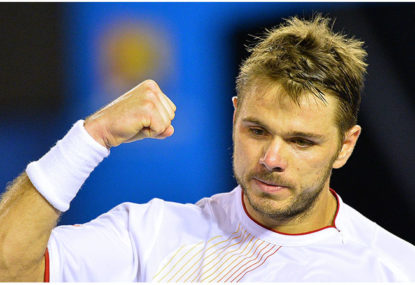Sweet revenge for Rafa as de Minaur downed to keep legend's Madrid fairytale alive
Alex de Minaur has missed out on the chance of a lifetime to beat Rafael Nadal on clay in successive tournaments, blown away by…

For the tennis purists, the fourth round marathon match between Stan Wawrinka and Milos Raonic was a delight.
In an era dominated by relentless slugging from the baseline, where players almost look collectively robotic, it was pleasing to see a throwback to a bygone era.
Raonic, the 13th seed, traded on his booming serve, which was nicely supplemented by a penchant for serve-and-volleying. Perhaps he wasn’t quite Pat Rafter in his propensity but, still, it was refreshing to see a player boldly charge towards the net regularly.
Wawrinka, the fourth seed and 2014 Australian Open champion, could not contain Raonic’s high-octane game. The five-set defeat perfectly encapsulated Wawrinka’s beguiling game. He had never lost to Raonic, having won all four matches previously.
Yet no one was particularly surprised that Wawrinka lost. He’s the ultimate hot and cold player, despite belatedly finding consistency in recent years.
But as he showed against Raonic, Wawrinka’s game often veers sharply from spectacular to ordinary within the same match. Often within minutes. He looked relatively listless in the opening two sets against Raonic before finally tapping into his magical bag of tricks just when it appeared he was heading for an embarrassing straight-sets loss.
Wawrinka had the momentum heading into the fifth before his game once again spiralled out of nowhere. It was a major letdown for such a talented player, who is genuinely capable of defeating the ‘Big Four’, yet isn’t reliable enough to be classified in their realm.
But who cares about substance when Wawrinka possesses the most lethal shot in tennis – his astounding one-handed backhand. Not only is it deadly, Wawrinka’s backhand is the most beautiful shot in the game. Every time he loads up on his backhand side, you expect something magical to happen.
Unfortunately, it is the last we’ve seen of it this tournament, as Wawrinka wasn’t quite able to harness it as he has on notable occasions in recent years.
Despite the early exit, and his standing as being a notch below men’s tennis’ absolute elite, I’m hoping Wawrinka’s indelible trademark will leave a lasting impression.
Every time Wawrinka plays, he’s become a must watch. This is mainly due to having watched him in person at the French Open final last year when he somehow – I’m still not sure how – inflicted Novak Djokovic’s only loss at a major in 2015.
Djokovic was riding a 28-game winning streak heading into the match, yet was jarringly ashen-faced during the final.
Djokovic’s perfectly put together game, where he has no evident weakness and is one of the greatest ever defensive players, was brutalised by Wawrinka.
Wawrinka’s game has an unbelievable touch to it. Simply, he is mercurial. When he is in rhythm and confident, Wawrinka can produce shots that no one, not even a superhero like Djokovic, can counter.
What makes Wawrinka so entertaining is that he is freewheeling against the top players. Smartly, he realises the only chance to beat them is by going into all-out attack mode.
That’s why you feel he is absolutely capable of beating the Big Four, yet strangely, he sometimes goes into his shell against lesser opponents. It’s as if he prefers being the underdog, where he can just unleash his game free from the suffocating shackles of expectation.
After his defeat in the French Open final, Djokovic was effusive and said: “He [Wawrinka] has probably the best one-handed backhand on the tour. No question, one of the best one-handed backhands that I have seen in tennis.”
I hope young tennis players were listening intently to Djokovic.
Wawrinka’s backhand drive is hit with plenty of topspin and his flowing racquet perfectly combines power and timing. The shot is ferocious but creates a lot of spin, putting opponents immediately on the defensive. Importantly, Wawrinka boasts versatility with his backhand as he can hit the ball flat down the line but also has the expertise to menacingly slice either short or long.
What makes Wawrinka’s prowess even more remarkable is that the one-hander is fading from the professional game with most modern players favouring the two-handed backhand. Roger Federer aside – perhaps the one-handed backhand is still in vogue in Switzerland – the one-hander is fast going the way of wooden rackets.
The two-hander is seen to be more reliable and compact, particularly in combating high-bouncing, top-spinning shots that have become key weapons for many top players. The two-hander is also seen to be more dependable for returning serve and defensive play.
In cricket parlance, the one-hander is like a batsman having an exaggerated high back-lift, like in the manner of Brian Lara. It’s perhaps dangerous, but in the grip of an expert, the technique and resulting shot making is aesthetically breathtaking.
Long overshadowed by compatriot Federer, Wawrinka, who will be 31 years old this year but is very much in his prime, has had an astounding last two years where he has beaten Rafael Nadal and Djokovic in Grand Slam finals, and was the fulcrum of Switzerland’s Davis Cup victory in 2014.
He’s unlikely to consistently dominate but Wawrinka is making men’s tennis more entertaining. He’s probably the only player on tour who legitimately terrifies the Big Four.
But perhaps his greatest legacy could be in rekindling a desire to play the one-handed backhand – the single most gorgeous shot in tennis – in a new generation of players.
He will be missed for the remainder of the Australian Open.